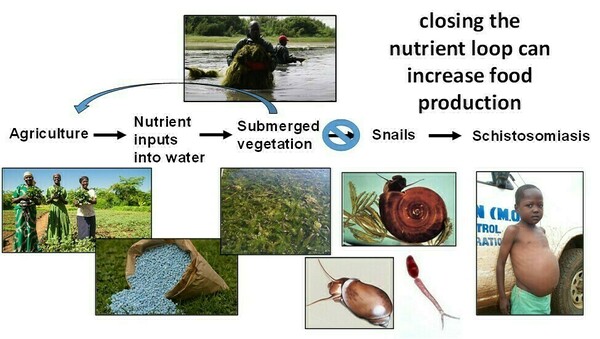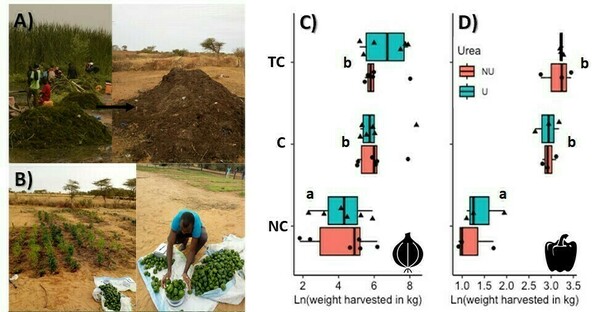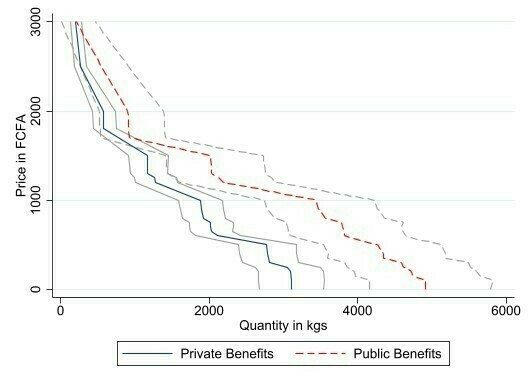Food, Sustainability, and Climate Change
Because aquatic plant overgrowth appears to be at least partially caused by runoff from agriculture, we hypothesized that we could profitably improve food production and sustainability by returning the nutrients captured in the removed plants back to agriculture, thus reducing nitrogen and phosphorus pollution by partly closing the nutrient loop (Fig. 1). Hence, this would turn a public nuisance (i.e., invasive vegetation) into a private good, which might promote greater intervention adoption.
 Fig. 1. Hypothesis that we could profitably improve food production and sustainability by returning the nutrients captured in the removed plants back to agriculture, thus reducing nitrogen and phosphorus pollution by partly closing the nutrient loop.
Fig. 1. Hypothesis that we could profitably improve food production and sustainability by returning the nutrients captured in the removed plants back to agriculture, thus reducing nitrogen and phosphorus pollution by partly closing the nutrient loop.
To test this hypothesis, we collaborated with local farmers and small-scale livestock owners (Fig. 2a,b, from Rohr et al. 2023) to evaluate whether the removed aquatic vegetation could be cost-effectively (i) converted to compost to increase crop yields (Fig. 2a-d), (ii) used as livestock feed (Fig. 2e-g), or (iii) used as fuel in biodigesters that produce both fertilizer and gas that can be used for cooking or for generators that produce electricity (see Energy, Sustainability, and Climate Change tab).
 Fig. 2. Use of nuisance aquatic vegetation as compost to increase food production and profits. (A) Photographs of aquatic vegetation and compost piles. (B) Photographs of pepper plots receiving compost, fertilizer, and tilling treatments and the farmer collecting data for the project. The compost increased (C) onion and (D) pepper production (kg of weight) per 11 m2 subplot independent of the cross-randomized tilling or fertilizer treatments (points: independent replicates, midlines: medians, boxes: first and third quartiles, whiskers: 1.5x interquartile range; C: compost, TC: tilled compost, NC: no compost, U: urea, NU: no urea; compost treatments with different letters are significantly different based on two-tailed tests with Bonferroni adjustments to an alpha of 0.05) Onion and pepper clipart were obtained using a Google image search with a creative commons filter.
Fig. 2. Use of nuisance aquatic vegetation as compost to increase food production and profits. (A) Photographs of aquatic vegetation and compost piles. (B) Photographs of pepper plots receiving compost, fertilizer, and tilling treatments and the farmer collecting data for the project. The compost increased (C) onion and (D) pepper production (kg of weight) per 11 m2 subplot independent of the cross-randomized tilling or fertilizer treatments (points: independent replicates, midlines: medians, boxes: first and third quartiles, whiskers: 1.5x interquartile range; C: compost, TC: tilled compost, NC: no compost, U: urea, NU: no urea; compost treatments with different letters are significantly different based on two-tailed tests with Bonferroni adjustments to an alpha of 0.05) Onion and pepper clipart were obtained using a Google image search with a creative commons filter.
Compost
The compost was reasonably high in moisture, nitrogen, and phosphorus, increased both onion and pepper production (total weight) independent of whether the compost was tilled in the soil or applied with fertilizer (Fig. 2c, d), and the disease onion rot was significantly greater in plots with both fertilizer and compost than compost alone (p < 0.001), further supporting the use of compost as a substitute for fertilizer (Rohr et al. 2023). Additionally, compost increased onion and pepper yields significantly more than urea fertilizer did (Fig. 2c, d), likely because it increased the water holding capacity of the soil. Conservative private benefit-to-cost ratios ranged from 2.7-4.0 and were always significantly greater than one, indicating that conversion of removed vegetation to compost was highly profitable, and much more profitable than urea fertilizer.
To further evaluate the value of the compost and animal feed to local communities, we 80 conducted experimental generalized second price auctions in 20 communities in the St. Louis-Richard Toll region of Senegal. We hypothesized that informing farmers and small-scale livestock owners that not only is the compost and animal feed good for their own production, but it also decreases schistosomiasis infection risk would increase their willingness to pay or bid for the compost and animal feed in the auction. We found that households that were randomly informed of the potential health benefits of aquatic vegetation removal prior to the auction were willing to pay about $3 USD more for compost or animal feed compared to households that were randomly informed of the potential health benefits after the auction. We use the experimental auction results to construct demand curves for compost (Fig. 3). Using estimates of the cost to produce compost, we found that information about the public health benefits of aquatic vegetation removal increased welfare by $3,951 USD in our small experimental auctions.
 Figure 3: Demand Curve for Compost by Treatment Arm. Private benefits represents auctions in the private productivity gains treatment arm. Public benefits represents auctions in the public health benefits treatment arm. The gray lines represent the 5th and 95th percentiles from 1,000 bootstrap replications.
Figure 3: Demand Curve for Compost by Treatment Arm. Private benefits represents auctions in the private productivity gains treatment arm. Public benefits represents auctions in the public health benefits treatment arm. The gray lines represent the 5th and 95th percentiles from 1,000 bootstrap replications.
Livestock Feed
Sheep, donkeys, and cattle, but not goats, readily consumed the removed aquatic vegetation suggesting that it might be useful as livestock feed (Fig. 4a-b, from Rohr et al. 2023). Using 17 female juvenile sheep and 13 female adult sheep, we iso-calorically substituted their typical purchased feed (a mix of peanut straw and pellets for juveniles, cornmeal for adults) with the removed aquatic vegetation (C. demersum) and tracked growth rates. The vegetation was first dried and ground with a pestle in an effort to kill any helminth eggs or cysts (including Fasciola spp.) and then reconstituted with water (see Methods in Rohr et al. 2023). We found no significant effect of any feed substitution level, up to the 60% maximum, on sheep weight gain or growth in either age group (Fig. 4c-d). When including labor costs, feeding sheep aquatic vegetation is 41 to 179 times cheaper than purchasing traditional feed for sheep. Using the removed vegetation as compost had a higher private benefit-to-cost ratio than using it as livestock feed. Including a highly conservative estimate for the public health benefit of reducing schistosomiasis adds 15-22% to the gross private benefits of using the vegetation as compost, resulting in total benefit-to-cost ratios of 3.1-8.8, while using vegetation as livestock feed sharply reduces costs (without loss of benefits) during those occasional periods when farmers supplement grazing with purchased feed (Rohr et al. 2023).
 Fig. 4. Use of nuisance aquatic vegetation as livestock feed to increase food production and profits. (A) Photographs of cattle and donkey readily consuming the removed aquatic vegetation, which is almost exclusively Ceratophyllum demersum. Goats refused to eat C. demersum. (B) Sheep and feeds used in our sheep trials. Final weights of (C) adult and (D) juvenile sheep were similar to controls when their normal diet was substituted iso-calorically with C. demersum up to 60% (shown are regression lines, jittered points representing independent sheep replicates, and 95% confidence bands). Age class of the sheep had no significant effect on sheep weight (F1,28=0.14, p=0.71; two-sided test).
Fig. 4. Use of nuisance aquatic vegetation as livestock feed to increase food production and profits. (A) Photographs of cattle and donkey readily consuming the removed aquatic vegetation, which is almost exclusively Ceratophyllum demersum. Goats refused to eat C. demersum. (B) Sheep and feeds used in our sheep trials. Final weights of (C) adult and (D) juvenile sheep were similar to controls when their normal diet was substituted iso-calorically with C. demersum up to 60% (shown are regression lines, jittered points representing independent sheep replicates, and 95% confidence bands). Age class of the sheep had no significant effect on sheep weight (F1,28=0.14, p=0.71; two-sided test).
Climate Change Mitigation
Worldwide, agriculture is the second-largest source of climate change pollution—and both the manufacturing and application of fertilizer has a heavy emissions toll. Thus, by recycling fertilizer captured in aquatic vegetation, we are reducing greenhouse gas emissions associated with fertilizer production and application. In fact, fertilizer that is not taken up by plants gets broken down by microbes, resulting in the release of nitrous oxide, which warms the planet 300 times as much as carbon dioxide.
For more information, see Rohr et al. 2023.